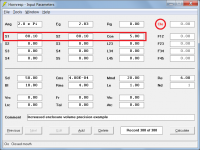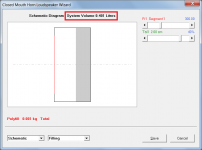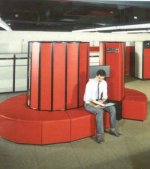Hi Sabbelbacke,
That is still much quicker than on my computer 🙂.
I have no idea - my knowledge of such things is zero 🙂. The slow speed is not really an issue for me though, as I don't produce polar maps very often anyway - only when testing requires it.
How is this for speed - the Cray supercomputer I posted a photograph of earlier (https://www.diyaudio.com/forums/subwoofers/119854-hornresp-954.html#post5785227), forms one "hemisphere" of the "brain" of the Square Kilometre Array, the world's largest telescope currently being built with one half in Australia and the other half in South Africa. When fully operational, the complete computer will produce a flow of data greater than that of the entire Internet combined. The SKA computer will be 25 percent faster than IBM's Summit, currently the fastest supercomputer in the world. It will be able to perform up to 100 million tasks simultaneously 🙂.
Kind regards,
David
I am now at 4:25 calculating time for your given example on my i5-4250u.
That is still much quicker than on my computer 🙂.
Do you see any chance to enable multiple threads in hornresp?
I have no idea - my knowledge of such things is zero 🙂. The slow speed is not really an issue for me though, as I don't produce polar maps very often anyway - only when testing requires it.
On modern CPUs with many cores, this could speed up things quite a bit.
How is this for speed - the Cray supercomputer I posted a photograph of earlier (https://www.diyaudio.com/forums/subwoofers/119854-hornresp-954.html#post5785227), forms one "hemisphere" of the "brain" of the Square Kilometre Array, the world's largest telescope currently being built with one half in Australia and the other half in South Africa. When fully operational, the complete computer will produce a flow of data greater than that of the entire Internet combined. The SKA computer will be 25 percent faster than IBM's Summit, currently the fastest supercomputer in the world. It will be able to perform up to 100 million tasks simultaneously 🙂.
Kind regards,
David
Do you see any chance to enable multiple threads in hornresp? On modern CPUs with many cores, this could speed up things quite a bit.
I have done some parallel programming, and depending on the algorithm it may take considerable effort to implement. Other cases can be quite simple. But you need a compiler that supports it, and i doubt David's VB6 compiler does 🙂
Hello David and Björn,
thank you for the feedback.
I suspected that this kind of calculation would be difficult to turn into parallel units for multithreading - thanx for Kolbrek for clarifying.
I just looked up some single thread performances - since CPUs nowadays are more about many cores, there are some hidden champions regarding single thread performance: The Intel Pentium G4560 for example is around 50 bucks and outperforms many much bigger CPUs in terms of single thread performance.
The slow speed is no issue for me, I was just curious - when waiting, I will get more coffee - or look up Supercomputers 🙂
thank you for the feedback.
I suspected that this kind of calculation would be difficult to turn into parallel units for multithreading - thanx for Kolbrek for clarifying.
I just looked up some single thread performances - since CPUs nowadays are more about many cores, there are some hidden champions regarding single thread performance: The Intel Pentium G4560 for example is around 50 bucks and outperforms many much bigger CPUs in terms of single thread performance.
The slow speed is no issue for me, I was just curious - when waiting, I will get more coffee - or look up Supercomputers 🙂
Thank you david for the info about the new supercomputer - I remember the times when crays were looking like some furniture out of a space station 🙂
Kind regards,
Sabbelbacke
Kind regards,
Sabbelbacke
Okay, I know we are in the subwoofer section, but I want to be able to investigate the low frequency performance of small, full range drivers (for use in severely limited spaces, to determine the best possible bottom end achievable with a small driver).
To help with that, is it possible to increase the precision of the enclosure volume from the current .01 litres to .001 litres? I'm assuming you are already using much higher precision calculations internally, so perhaps only the GUI field and associated input code will need to be changed (and the wizard, of course).
To help with that, is it possible to increase the precision of the enclosure volume from the current .01 litres to .001 litres? I'm assuming you are already using much higher precision calculations internally, so perhaps only the GUI field and associated input code will need to be changed (and the wizard, of course).
is it possible to increase the precision of the enclosure volume from the current .01 litres to .001 litres?
Hi SamAnytime,
The precision of Vrc is not going to change - I simply cannot justify the work involved to make it happen, particularly given the limited application the feature would have.
To get around the problem, simulate your small enclosure as a closed-mouth segment, as shown in the attached example. As an added bonus, you will now also be able to include absorbent filling material.
Kind regards,
David
Attachments
I remember the times when crays were looking like some furniture out of a space station 🙂
Me too 🙂.
Attachments
Compute Bound Problems
may be accelerated by the simple use of in-line code in loop bodies that permits use of large index increments (step size) to reduce loop iteration overhead. If your system is memory deficient, then VM swaps will slow the process to a crawl as well. Also, write such routines in C and compile them into a sub-routine library that supports calls from VB6. WHG
I have done some parallel programming, and depending on the algorithm it may take considerable effort to implement. Other cases can be quite simple. But you need a compiler that supports it, and i doubt David's VB6 compiler does 🙂
may be accelerated by the simple use of in-line code in loop bodies that permits use of large index increments (step size) to reduce loop iteration overhead. If your system is memory deficient, then VM swaps will slow the process to a crawl as well. Also, write such routines in C and compile them into a sub-routine library that supports calls from VB6. WHG
Last edited:
Me three! That picture is from the 80s!Me too 🙂.
HP just bought Cray. Now all Cray computers will come with a few terabytes of bloatware....
HP just bought Cray. Now all Cray computers will come with a few terabytes of bloatware....
Well, you wouldn't want to run out of ink for your print spooler, would you?
how to interpret MMJ's pre-stub Hornresp stubby Karlson kluge model?
I clearly see the stub but am a bit confused on the front chamber volume (and port length - although assume MMJ intended 1/2" Baltic birch plywood in the build)
To me it appears ~28 liter (not considering 6 liters added by the stub which physically sits at the top of the cabinet "above" the port.
I know this isn't "legit" use of hornresp but maybe (?) worth a build.
(MMJ must be concentrating on Facebook these days.)


I clearly see the stub but am a bit confused on the front chamber volume (and port length - although assume MMJ intended 1/2" Baltic birch plywood in the build)
To me it appears ~28 liter (not considering 6 liters added by the stub which physically sits at the top of the cabinet "above" the port.
I know this isn't "legit" use of hornresp but maybe (?) worth a build.
(MMJ must be concentrating on Facebook these days.)


that's MMJ's kluge of a Karlson's chamber - he didn't state "why"
fwiw MMJ's constricted transflex kludge for the little Acoustic Control 115bk looks pretty good. How would you simulate a Karlson with hornresp?

fwiw MMJ's constricted transflex kludge for the little Acoustic Control 115bk looks pretty good. How would you simulate a Karlson with hornresp?

Last edited:
Hornresp Update 5000-190523
Hi Everyone,
CHANGE
Previously the only way to remove the error message generated when a closed mouth was specified on a horn with a closed rear chamber was to set Vrc and/or Lrc to zero. Now the error message can also be removed by double-clicking on the Clo label.
Kind regards,
David
Hi Everyone,
CHANGE
Previously the only way to remove the error message generated when a closed mouth was specified on a horn with a closed rear chamber was to set Vrc and/or Lrc to zero. Now the error message can also be removed by double-clicking on the Clo label.
Kind regards,
David
Attachments
Hi David !
Here is discussed :
What do you think about it David ?
Thanks,
Damien
Here is discussed :
[...]View attachment 759217
Updated with port in HH chamber.
View attachment 759218
Difference between 8th order Parallel tuned and Series tuned bandpass box.
As far as I know Hornresp can´t simulate the series tuned 8th order. Only series tuned 6th order (tapped horn).
- wonder how much work / trouble would be involved for David McBean to add a series 8th order BP option ? (a Karlson with a "tight" rear lowpass shelf would roughly resemble that type)
Or adding a TH2 mode speaker-L12-Speaker-L23-L34-L45
L34 as chamber using stepped segment.
It doesn't hurt to ask!
What do you think about it David ?
Thanks,
Damien
What do you think about it David ?
Hi Damien,
I have a number of non-Hornresp projects competing for my time at the moment. I will look at the possibility of including the BP8S option when I get a chance. It is not going to happen tomorrow, though 🙂.
Kind regards,
David
If I understand correctly DVC sub specs are typically quoted with the VCs in parallel. To simulate the driver with one coil unused (left open) would you just double Re and Qes while cutting Le in half?
That depends upon what you are trying to accomplish. You are basically correct in what you have stated. But also consider that coils in series allow you a greater motor force. This may also prove to be useful.
- Home
- Loudspeakers
- Subwoofers
- Hornresp



